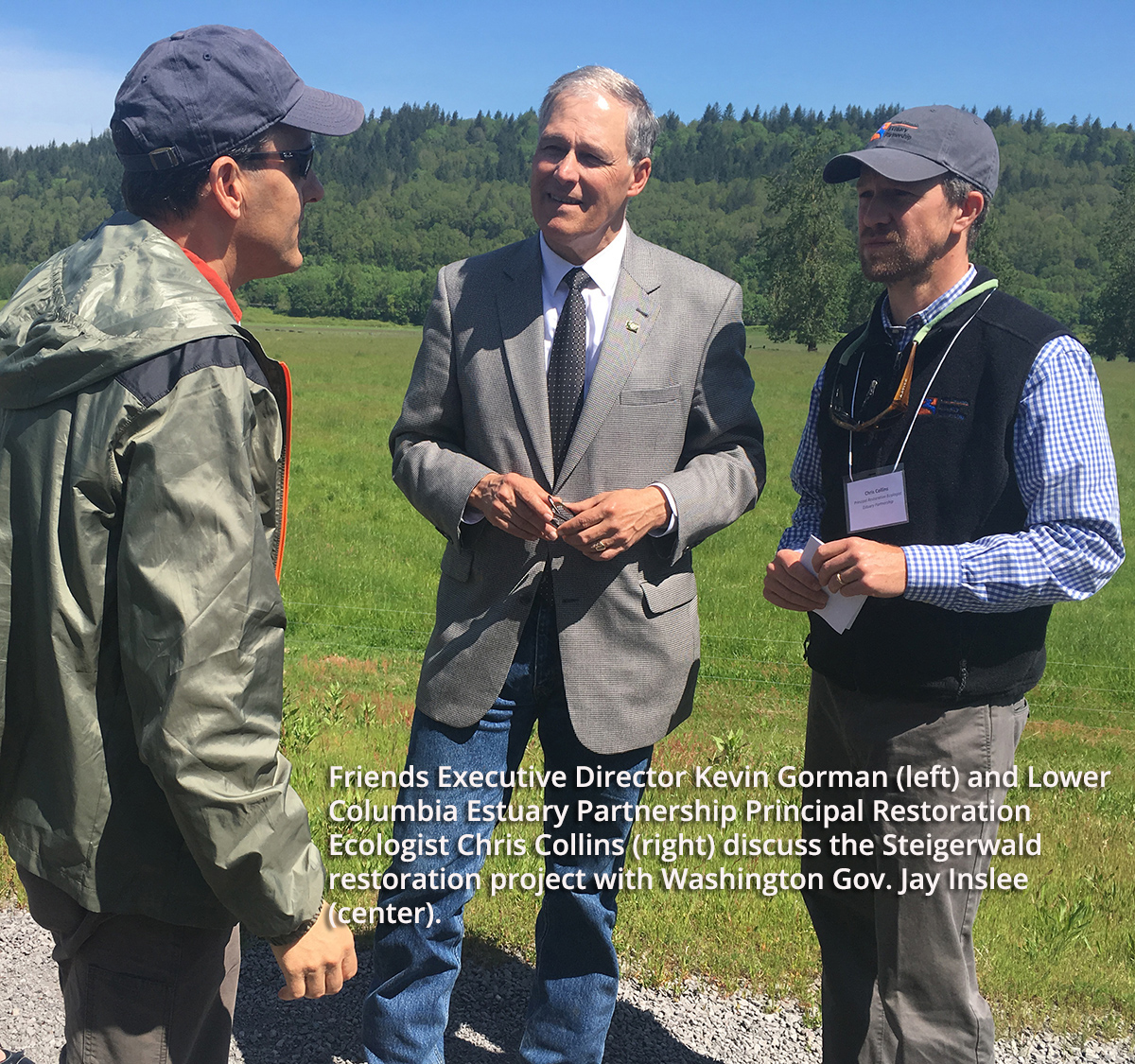Community Partners: Steigerwald Shores Floodplain Restoration

Gorge Partnership Restores Salmon Resting Habitat
Years of collaboration between Friends and many partners results in the largest habitat restoration project in Gorge history.
By Laura O. Foster
Steigerwald Lake National Wildlife Refuge at the west end of the Gorge has long been a wildlife haven, with 200 bird species visiting annually. Now, significant improvements are coming to the refuge with the restoration of 965 acres of floodplain that had been cut off from the Columbia by a 1966 levee. In 2020, when a 2.25-mile-wide breach in the levee lets the river back in, salmon can again return to the floodplain to rest and grow in its quiet waters. Construction is expected to be complete in 2021.
The lead partner in the $22 million project is the Lower Columbia Estuary Partnership. Since 2000, it has worked on more than 200 restoration projects within the estuarial and tidal portions of the river and its tributaries. LCEP proposed the $22 million project to Bonneville Power as one that would address the utility’s fish recovery goals.
Friends has worked with LCEP on other habitat restoration projects, including Benson State Park and Horsetail Creek. This project was significantly more involved. Chris Collins, LCEP’s principal restoration ecologist notes, “The size, many stakeholders, and multiple components of this project make it by far the biggest and most complicated project LCEP has done.”
After the section of river levee is removed, two new setback levees at the refuge’s east and west ends will be built perpendicular to the river, protecting adjacent lands from flooding. Washington’s SR 14 on the refuge’s north boundary will be raised above the 500-year flood level. A failed diversion structure at Gibbons Creek will be removed, the creek’s alluvial fan restored, and its waters freed from an artificial, elevated canal, allowing it to flow in wide meanders through the floodplain. Instead of a narrow fish ladder, fish can swim into the wetlands via a series of channels. New trails, new habitat, new opportunities for education, and significant savings on flood control for the adjacent Port of Camas-Washougal has made the project a win for every one of the many partners involved.
Friends’ purchase of Steigerwald Shores is catalyst
The habitat restoration would never have happened without the Friends of the Columbia Gorge Land Trust's multiyear negotiations to purchase Steigerwald Shores, 160 acres east of the refuge. In 2018, with the success of the $5.6 million Preserve the Wonder campaign, the purchase was finalized. Close to 40 percent of the levee to be removed is on the Steigerwald Shores’ 1 mile of river frontage. Debrah Marriott, executive director of LCEP says, “We’d identified the Steigerwald project as a priority before we knew Friends was pursuing Steigerwald Shores, since it represents a rare opportunity to restore a large floodplain area. But without that property, we would have had to build a longer setback levee, and that wasn’t cost effective.”
Another major stakeholder is the project is the Port of Camas-Washougal. Its focus on recreation as an economic driver has made it a vital partner in Gorge Towns to Trails, Friends’ vision for a Gorge-wide trail network linking towns with natural areas. With the completion of a trail segment in 2019, the Port and City of Washougal will have a 6-mile-long waterfront trail linking downtown’s restaurants and Washougal Waterfront Park to the east end of Steigerwald.
Executive director Dave Ripp says, “The Port is trying to be a good steward, and we see the environmental benefits of returning the natural flow of the creek and river to Steigerwald. The refuge also brings much economic benefit to Washougal—when people come to bird watch, or hike, or take photos, dollars flow to restaurants and local businesses.”
Steigerwald is managed by the U.S. Fish and Wildlife Service. Three years ago, it was selected as one of the nation’s Urban Wildlife Refuges, places close to large metropolitan areas that offer excellent opportunities to engage urban communities as partners in wildlife conservation. Chris Lapp, refuge project leader, says, “Our focus is on making conservation relevant; to bring people to the refuge and have them take their role in conservation back home with them. We want to erase the separation between people and wildlife.”
In addition to the massive habitat enrichments, Rapp says the changes at Steigerwald meet FWS’s goals for environmental education and interpretation. With its position as a Gorge gateway and its flat, accessible ground, Steigerwald is an ideal introduction to the Gorge’s natural habitats and viewsheds for everyone—traditional users like birders and hikers, and those who don’t even know yet what a refuge is.
Working with Friends on Gorge Towns to Trails and the Steigerwald habitat restoration, Lapp says, “From land acquisitions to the benefits of long term connectivity with Gorge trails, we have a very healthy partnership with Friends. When it comes to creating a positive public experience for Gorge visitors, we’re all on the same page.”
Laura O. Foster has written eight guidebooks about Portland and the Columbia River Gorge National Scenic Area. Her work has been featured on Oregon Field Guide, Oregon Art Beat, and AM Northwest, and in Portland Monthly, Willamette Week, the Portland Tribune, and The Oregonian. She has been an Oregonian since 1989.
View Profiles
View 2017-18 Annual Report

